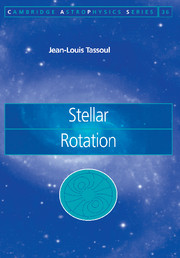Preface
Published online by Cambridge University Press: 15 August 2009
Summary
When I wrote my first book – Theory of Rotating Stars (Princeton: Princeton University Press, 1978) – I was not aware of the fact that the 1970s were a period of transition and that major unexpected developments would take place in the field of stellar rotation during the 1980s.
In the mid-1970s, we had no direct information about the internal rotation of the Sun. Little was known about the rotation of main-sequence stars of spectral type G and later, although it was already well established that the surface rotation rate of these stars decayed as the inverse square root of their age. We certainly had much more information about axial rotation in the upper-main-sequence stars, but the actual distribution of specific angular momentum within these stars was still largely unknown. On the theoretical side, important progress in the study of rotating stars had been made by direct numerical integration of the partial differential equations of stellar structure. However, because there was no clear expectation for the actual rotation law in an early-type star, the angular momentum distribution always had to be specified in an ad hoc manner. The presence of large-scale meridional currents in a stellar radiative zone was also a serious problem: All solutions presented to date had unwanted mathematical singularities at the boundaries, and the back reaction of these currents on the rotational motion had never been properly taken into account.
- Type
- Chapter
- Information
- Stellar Rotation , pp. xiii - xviPublisher: Cambridge University PressPrint publication year: 2000

